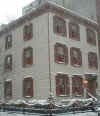 |
New York
Architecture Images-Greenwich Village 14-16 Grove Street |
|
architect |
builders: Samuel Winant & John Degraw |
|
location |
14-16 Grove Street |
|
date |
1840s |
|
style |
Federal Style |
|
construction |
brick |
|
type |
House |
|
|
|
|
images |
|
|
|
Special thanks to www.forgotten-ny.com |
|
The house at 17 Grove Street was built in
1822, the year that an outbreak of yellow fever led many New Yorkers to
seek the safety of rural Greenwich Village. Built by a windowsash maker,
the house is the largest and most intact of the Village's remaining
wood-frame structures, which were outlawed for fire prevention in 1866.
Originally of two stories, the house gained a third floor in 1870. The
sash maker's workshop, visible behind the house on Bedford Street,
became a single-family residence. The mock half-timbered "castle" at 102
Bedford Street was the result of a 1925 renovation by amateur architect
Clifford Reed Daily of an 1835 row house. Supported by opera impresario
and art patron Otto Kahn, Daily embodied the stereotype of the Greenwich
Village "eccentric" and set out to create a home appropriate to "the
minds of creative Villagers."
In 1987, 17 Grove Street and the workshop were purchased for $1.1 million and have been meticulously restored, a quintessential example of contemporary gentrification. A good example of 19th century row houses, this set of buildings shows the transition to the Greek Revival Style from the Federal Style houses of early New York. The houses here are one story taller than the typical Federal Style row house and show the introduction of more elaborate detail, including classical elements, on the plain red brick facades. #17 Grove Street was built in 1822 by window sash maker William Hyde, and is one of Manhattan's few remaining wood-frame houses (as is 100 Bedford, seen just behind the house to the left; it was also built by Hyde). The unusual building at the rear, 102 Bedford, is known as "Twin Peaks": built in 1835, it was controversially renovated in 1926. |
|